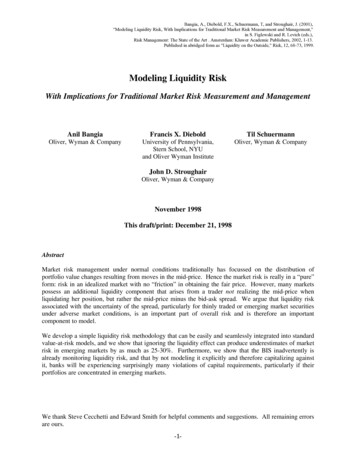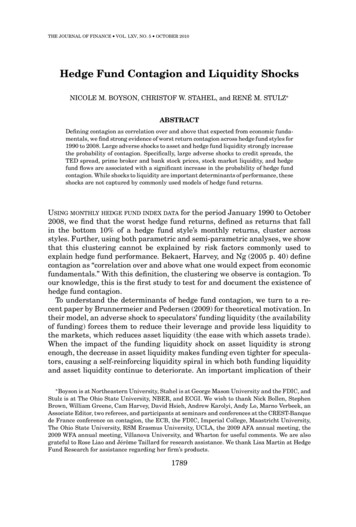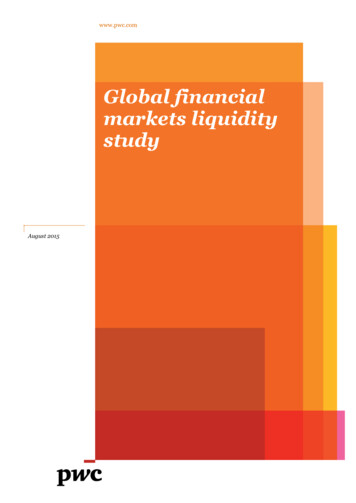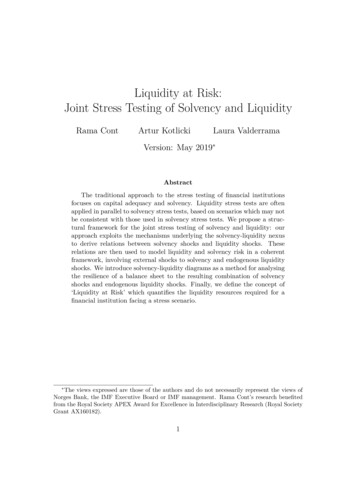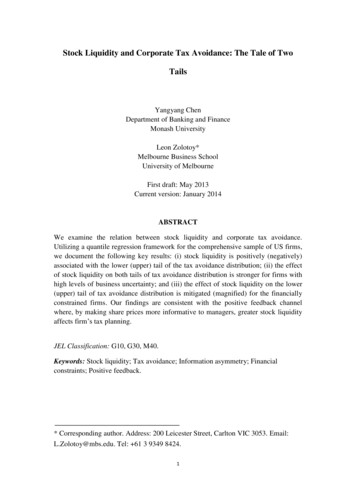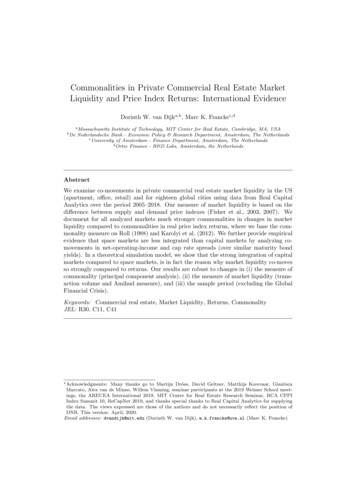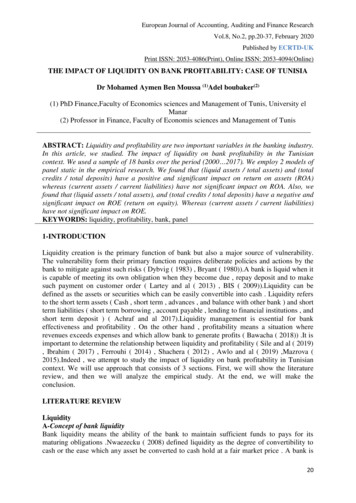
Transcription
European Journal of Accounting, Auditing and Finance ResearchVol.8, No.2, pp.20-37, February 2020Published by ECRTD-UKPrint ISSN: 2053-4086(Print), Online ISSN: 2053-4094(Online)THE IMPACT OF LIQUIDITY ON BANK PROFITABILITY: CASE OF TUNISIADr Mohamed Aymen Ben Moussa (1)Adel boubaker(2)(1) PhD Finance,Faculty of Economics sciences and Management of Tunis, University elManar(2) Professor in Finance, Faculty of Economis sciences and Management of TunisABSTRACT: Liquidity and profitability are two important variables in the banking industry.In this article, we studied. The impact of liquidity on bank profitability in the Tunisiancontext. We used a sample of 18 banks over the period (2000 2017). We employ 2 models ofpanel static in the empirical research. We found that (liquid assets / total assets) and (totalcredits / total deposits) have a positive and significant impact on return on assets (ROA)whereas (current assets / current liabilities) have not significant impact on ROA. Also, wefound that (liquid assets / total assets), and (total credits / total deposits) have a negative andsignificant impact on ROE (return on equity). Whereas (current assets / current liabilities)have not significant impact on ROE.KEYWORDS: liquidity, profitability, bank, panel1-INTRODUCTIONLiquidity creation is the primary function of bank but also a major source of vulnerability.The vulnerability form their primary function requires deliberate policies and actions by thebank to mitigate against such risks ( Dybvig ( 1983) , Bryant ( 1980)).A bank is liquid when itis capable of meeting its own obligation when they become due , repay deposit and to makesuch payment on customer order ( Lartey and al ( 2013) , BIS ( 2009)).Liquidity can bedefined as the assets or securities which can be easily convertible into cash . Liquidity refersto the short term assets ( Cash , short term , advances , and balance with other bank ) and shortterm liabilities ( short term borrowing , account payable , lending to financial institutions , andshort term deposit ) ( Achraf and al 2017).Liquidity management is essential for bankeffectiveness and profitability . On the other hand , profitability means a situation whererevenues exceeds expenses and which allow bank to generate profits ( Bawacha ( 2018)) .It isimportant to determine the relationship between liquidity and profitability ( Sile and al ( 2019), Ibrahim ( 2017) , Ferrouhi ( 2014) , Shachera ( 2012) , Awlo and al ( 2019) ,Mazrova (2015).Indeed , we attempt to study the impact of liquidity on bank profitability in Tunisiancontext. We will use approach that consists of 3 sections. First, we will show the literaturereview, and then we will analyze the empirical study. At the end, we will make theconclusion.LITERATURE REVIEWLiquidityA-Concept of bank liquidityBank liquidity means the ability of the bank to maintain sufficient funds to pays for itsmaturing obligations .Nwaezecku ( 2008) defined liquidity as the degree of convertibility tocash or the ease which any asset be converted to cash hold at a fair market price . A bank is20
European Journal of Accounting, Auditing and Finance ResearchVol.8, No.2, pp.20-37, February 2020Published by ECRTD-UKPrint ISSN: 2053-4086(Print), Online ISSN: 2053-4094(Online)liquid when it is capable of meeting its own obligations when they become due, repaydeposits and to make such payment based on customer order (Lartey and al 2013; BIS 2009)Alshatti(2015) argues that liquidity is the ability of banks to meet the financial needs of theirincreased assets and meeting ability as when they fall due without the occurrence ofunforeseen losses. For commercial banks ,Adalestinsson ( 2014) points out the liquidity canbe achieved through 3 different ways , the first are is the sale of assets , the second way is toborrow money from credits in financial markets , and the third way is relied on the repaymentof debts from debtors .B-Anticipated income theoryAccording to Sobyibo( 2014) , the anticipated theory of liquidity particularly focuses on longterm advances . According to this theory , regardless of the nature and character of aborrower’s business , the bank plan the liquidation of the term loan from the anticipatedincome of the borrower . A term loan is for a period exceeding one year and extending to lessthan 5 years .C-Shiftability theoryIn accordance to Alshatti( 2016) , the shiftability theory is a process by which bankinterchange or exchange its assets for the extreme liquid when there is pancity of liquidity .Shiftability is an approach to keep bank liquidity supporting the shiftability of assets. When abank is short of ready money, it is able to sale or repo its assets to be a more liquid bank.D-Commercial loan theoryThis theory states that whenever commercial banks make short term self-liquidatingproductive loans , the central bank should lend to the banks on the security of such short termloans .E-The trade-off theoryThis states that there is opportunity cost for a bank either pursuing to be liquid or profitable.Under this theory, banks that choose to be liquid will not be profitable and vice versa . As thetow fundamental goals cannot be achieved together, for banks to be solvent and maintain toinstitute an efficient financial management practices that will balance the liquidity andprofitability trade-off so that banks can be optimally liquid and profitable. The majorargument against this theory isthat is based on banks’ ability to make profit on grantingsubstantial part of its liquid resources as loan from which it can earn interest income . ( Kajolaand al ( 2019) .F-liquidity regulationLiquidity plays a significant role in the sustainable development of bank and the stability offinancial system , strict liquidity regulation are supposed to put forward to guard againstproblems due to the lack of liquidity ( Bawacha ( 2018) ).Rochet ( 2008) indicates 2 reasons for liquidity regulation , from micro-point of view ,liquidity regulation from prevent bankruptcy and damage of depositors interest by regulationliquidity buffers of banks , from macro-point of view , liquidity regulation help maintenanceof financial system ability .The 2008 global financial crisis reminded financial institutions to that of liquidity risk onfinancial system .21
European Journal of Accounting, Auditing and Finance ResearchVol.8, No.2, pp.20-37, February 2020Published by ECRTD-UKPrint ISSN: 2053-4086(Print), Online ISSN: 2053-4094(Online)Basel III focused on liquidity by introducing liquidity coverage ratio and net stable funding (LCR) , ratio ( NSFR) .LCR high quality assets / 30 days net cash outflowsNSFR Available stable funding / required stable fundingNSFR( net stable funding ratio ) measures the bank ability to get access to stable funding ,this ratio comes out to make sure banks have available the stable funding with 1 year period .( Bawacha ( 2018)).Bank profitabilityLike all business, bank profit by earning more money throw what they pay in expenses, themajor position of a bank profit comes from fees that it charges for its services and the interestthat it earns on its assets.Profitability maximization is the ultimate goal for banks because of their for profit essence.Two aspects are concerned with profitability, the revenues generated and the cost. Thus, theaway of improving, profitability includes enhancing revenues and minimizing costs.The profitability of banking sector is important with to aim to estimate the constancy andreliability of the financial and banking industry (Albertazzi and Gambacorta 2009). Theprofitability is represented by 3 alternatives variables ( Kabejeh and al 2012) . First, mostimportant profitability ratio is ROA, also ROE . The next is the return on investment ( ROI) ,it measures the bank’s efficiency by using invested capital. Earnings per share serve as apointer of bank’s profitability (Pearce and al 1987).The relationship between bank liquidity and bank profitabilityThere are many researches that studies the relationship between bank liquidity and bankprofitability.Shachera( 2012) studied listed banks in Iran for the period ( 2002 2009) . Hefound that liquidity has significant impact on bank profitability .Warrad and al (2015) studied15 Jordanian banks listed at Amman Stock exchange (ASE) . They found significant impactof liquidity (quickratio ) on ROA ( Return on assets ) . Nishanthini and Merrajancy(2015)studied a sample of banks in Sirilanka over the period (2008 2012) . We found that liquidityhave not significant impact on bank profitability.Vodova( 2016) studied the impact of liquidity on profitability of the polish banking industryover the period ( 2007 2013) . He found that liquidity has a negative impact on bankprofitability .Also Abulaila ,Alhathlool ( 2016) studied banks in Saudia . They found nosignificant relationship between liquidity and bank profitability .Salim and Bilal ( 2016)studied 4 commercial banks in Oman for the period ( 2010 2014) . They found significantrelationship between bank liquidity and bank profitability.Moreover , Mebounon and al (2016) examined 38 banks in WAEMU region for the period ( 2001 2011).They found a nonlinearrelationship between bank liquidity and bank profitability .Also Achraf and al ( 2017)studied 10 banks in Pakistan for the period ( 2006 2015) . They found that quick ratio has anegative impact on bank profitability , whereas cash and current ratio has a positive impact onbank profitability .Also Ibrahim ( 2017) examined the influence of liquidity on the profitability of Iraqi banksover the period ( 2005 2013) . He found a significant impact of liquidity on bankprofitability.22
European Journal of Accounting, Auditing and Finance ResearchVol.8, No.2, pp.20-37, February 2020Published by ECRTD-UKPrint ISSN: 2053-4086(Print), Online ISSN: 2053-4094(Online)Hakimi and Zaghdoudi( 2017) studied a sample of 10 Tunisian banks over the period (1990 2013) . They found that liquidity (measured by total credits / total deposits) has anegative effect on bank profitability ( NIM) .Munithi and Waweru ( 2017) studied 41commercial of banks in Kenya . They measured liquidity by liquidity coverage ratio ( LCR)and net stable funding ratio ( NSFR) while profitability is measured by ROE ( return onequity) . Panel data techniques of random effect estimation and generalized method ofmoments were used to purge time invariant observed specific effect and to mitigate potentialendoegneityproblems. Findings indicate that NSFR is negatively associated with bankprofitability both in long run and short run while LCR does not significantly influence theprofitability of commercial banks in long run and short run .Charmler and al (2018) studied a sample of 21 banks in Ghana over the period ( 2007 2016).They found that liquidity is positively associated with bank profitability .Moreover, Lucy andal (2018) studied a 5 banks in Nigeria for the period ( 2007 2016) . They found that liquidityhas positive and significant effect on bank profitability .On the other hand,Bawacha( 2018)studied a sample of 50 banks in Asia , Europe , North America . The findings of this studythat only DAR (deposit to assets ratio) significantly impact on profitability (Return on equity ).Moreover Mohanty and Mehrota ( 2018) studied 27 public sector banks and 20 private sectorbanks in India for the period ( 2011-2012) and ( 2015-2016) .They found that there is anegative effect of cash deposit ratio and investment deposit ratio on ROA . But there is nosignificant effect of liquidity on ROE .Ghurtskaia and Lemonjava (2018) indicated that therelationship is positive between liquidity and bank profitability in the Georgian context.Also Awlo and al (2019) studied the impact of liquidity on bank profitability in Ethiopia overthe period ( 1986 2017) . Autoregressive distributed lag model ( ARDL) is used toinvestigate the short run and long run effect of liquidity on profitability .Current ratio and loanto deposit ratio of the bank were used to measure liquidity while ROA is dependent variable (measure of profitability ) . They found that loan to deposit ratio negatively affect return onassets in the long run , while current ratio significantly and positively affects ROA in the longrun .Sahyouni and wang ( 2019) estimated the amount liquidity created by Syrian banksbetween ( 2004---2010) and further investigates the effect of liquidity creation on bankperformance , controlling for set a bank level , industry level , and macroeconomic variables.The findings show that bank liquidity creation improved during the prewar period andshowed positive figure , but started to decline sharply during wartime .Besides Sile and al (2019) studied 43 commercial banks in Kenya over the period ( 2012 2016) . They found thatthere is a negative relationship between liquidity and profitability .Empirical studyThe relationship between bank liquidity and bank profitability has been the object of severalstudies prompting us to study this problematic in the Tunisian context .Under this section , we will identify the sample at the beginning and then we specify thevariables and the model .After we carry out the necessary econometric tests . Finally we show the estimation results ofthe model and their interpretations .23
European Journal of Accounting, Auditing and Finance ResearchVol.8, No.2, pp.20-37, February 2020Published by ECRTD-UKPrint ISSN: 2053-4086(Print), Online ISSN: 2053-4094(Online)SampleWe will use 11 banks(BIAT , STB , BNA , BH , ATB , Amen Bank , BH , BTEI , BT,Atttijari bank ,UBCI) that belong to professional association of banks in Tunisian over theperiod ( 2000---2017) . Financial data are collected through the annual reports of banksexisted in the web site of the professional association of banks in Tunisia over the period (2000----2017).Estimation methodWe will utilize panel static because it controls :-The time and individual variation in the observable behavior or cross sectional times seriesaggregated-The observed or unobserved individual heterogeneitySpecification of variablesWe will estimate the following models :ROA i,t b0 b1 Sizei,t b2. CAPi,t b3.TLAi,t b4. CEAi,t b5 CFCi,t b6. Tdepositi,t b7 CEAi,t b8 CFCi,t b9 Tdepositi,t b 10.TPIBi,t b 11.TINFi,t Ei,tROEi,t b0 b1 Sizei,t b2.CAPi,t b3. TLAi,t b4. ALAi,t b5. CDi,t b6.CRi,t b7.CEAi,t b8. CFCi,t b9. Tdepositi,t b10. TPIBi,t b11. TINFi,t Ei,tWhere :i bankt timebo constantb1, b2, b3, b4, b5, b6, b7, b8 , b9 ,b10, b11:Parameters to be estimatedROA return on assets net income / total assetsROA shows how to generate income from the assets of the bank ( Chin 2011) . It measuresthe profit earned per dollars of assets and reflect how well bank management uses the bank’sinvestment resources to generate profits ( Naceur 2003) . ROA is considered as the best proxyof profit ( Flamini and al ( 2009) , Samad ( 2005)).ROE return on equity net income / total equityROE reflects the ability of bank to use its own funds to generate profits ( Yilmaz 2013)This ratio shows the profit earned per 1 dinar of investment . This is an indicator of how wellbank uses investor’s money or generate profits .( Chouikh , Blagui ( 2017)).Size size of the bank natural logarithm of total assetsSize can show the economies of scale . The large banks benefit from economies of scalewhich reduces the cost of production and information gathering ( Boyd , Runkhle ( 1993)) .ALA liquid assets / total assetsALA depicts the bank’s ability to absorb the liquidity shocks. In theory the higher liquidityratio indicates that the bank is better position to meet its stochastic withdrawals ( Chagwiza(2014)) .24
European Journal of Accounting, Auditing and Finance ResearchVol.8, No.2, pp.20-37, February 2020Published by ECRTD-UKPrint ISSN: 2053-4086(Print), Online ISSN: 2053-4094(Online)CEA operating expenses / Total assetsOperating expenses including personal expenses and other expenses. CEA shows the weightof operating expenses compared to total assetsCFC Financial expenses / total creditsFinancial expenses include interest expense due to loan made in the money market and thecapital market by banks. CFC shows the share of financial expenses in relation to total creditsT deposit total deposits / total assetsDeposit include demands deposits and term deposits. T deposit show the share of depositscompared to total assets. The more the deposits a bank collect, the more the loanopportunities, it will be able to generate further profit ( Mencucci , Paolucci ( 2016)).CD total credits / total depositsIt is the ratio that describes how allocation of funds in term de deposits, comparing to anumber of funds which is obtained from saving ( Widyastuti and al ( 2017)). When this ratiois higher , it show more risky conditions because the funds from deposits have been collectedin more of credit .Conversely the lower ratio indicate effective banks in lending decisions .TPIB Growth rate of gross domestic productTPIB show the growth in the economy activity in the country .Ayadi ,Boujelbene ( 2012) ,Asarkaya , Ozcan ( 2007) pointed out the when economic growth increase , the banks makemore profit .CR current assets / current liabilitiesThis is the proportion of bank’s current assets to its current liabilities . It shows the strength ofthe bank in meeting the short term maturing obligations to the claimant of those obligations.(Kajola and al ( 2019).TLA total credits / total assetsBank loans are the main course of return and are anticipated to impact positively the profits (Menicucci , Paolucci ( 2016))CAP total equity / total assetsThe capital strength of bank indicates its capacity to meet deposit demand and sends signals tobank customers about its stability and ability to protect their savings especially during periodsof uncertainty such as the financial crisis (Ghosh 2016; Berger (1995).It is largely assumedthat well capitalized banks challenge lower probable cost of financial distress and suchcircumstances will then be turned into high profitability ( Abreu , Mendes ( 2002).TINF rate of inflationTINF shows the rate of increase in the price index. Inflation is generally the persistenceincrease of price level of goods and services .We test the following hypotheses :H1: (Liquid assets / total assets) have a positive impact on ROA25
European Journal of Accounting, Auditing and Finance ResearchVol.8, No.2, pp.20-37, February 2020Published by ECRTD-UKPrint ISSN: 2053-4086(Print), Online ISSN: 2053-4094(Online)H2: (Total credits/ total deposits) have a positive and significant impact on ROAH3 (Liquid assets / total assets) have a negative and significant impact on ROEH4: (Total credits / total deposits) have a negative and significant impact on ROEH5: (Current assets / current liabilities) have a significant impact on ROAH6: (Current assets / Current liabilities) have a significant impact on ROEAnalysis of descriptive statisticsTable 1 :Descriptive statisticsVariableObservation 198 11*18 total number of observations18 Number of years ( 2000 2017)11 Number of banksROA ( mean 0.0114) . The net income represent on average 1.14% of total assetsROE ( mean 0.087) . The net income represent on average 8.7% of total equitySize ( mean 14.058) . Most banks have a small and medium size . There is no largevariation in size of banksCAP ( mean 0.1626) . The equity represent on average 16.26% of total assets .But there is a large variation in capital between banks . Standard deviation 17.05%TLA ( mean 71.65%) . Total credit represent on average 71.65% of total assets . Thestandard deviation is high ( 19.210)ALA ( mean 0.037) . Liquid assets represent on average 3.7% of total assetsThe standard deviation is low 0.04CEA ( mean 0.026) . Operating expenses represent on average 2.6% of total assets .Standard deviation is low ( 0.021)CFC( mean 0.0324) . Financial expenses represent on average 3.24% of total credits .Standard deviation is low 2.6%There isn’t a big difference between banks in term of financial expenses .T deposit ( mean 0.6545) . Total deposit represent on average 65.45% of total assets . Thestandard deviation is high 26% . There is a big difference between banks in term of deposits .TPIB ( mean 3.29%) . The economic growth is not good . It is negative in 2011 because ofrevolution .26
European Journal of Accounting, Auditing and Finance ResearchVol.8, No.2, pp.20-37, February 2020Published by ECRTD-UKPrint ISSN: 2053-4086(Print), Online ISSN: 2053-4094(Online)TINF ( mean 4.1%) . The rate of inflation is acceptable . Standard deviation is not high .There is not big difference between years but after revolution of 2011 this rate will be high .CD ( mean 3.75) In average , total credits represent 3.75 of total deposit , it is a greatstandard deviation between banks .CR ( mean 1.11) . In average , current assets represent 1.11 current liabilities .The difference is big in term of CR between banks .( Standard deviation 20.20) is high .Econometric testsA-Mutlicolineraity testTable 2 Correlation between 26-0.068-0.0792Table 3 Suite of correlation between variablesCFCTALACDdeposit1.000CFC1.000Tdeposit 00.1367-0.151.0000.00901.00027
European Journal of Accounting, Auditing and Finance ResearchVol.8, No.2, pp.20-37, February 2020Published by ECRTD-UKPrint ISSN: 2053-4086(Print), Online ISSN: 2053-4094(Online)There is no problem of multicolinearity because all coefficients are inferior to 80%Table3 :VIF valuesVariableVIFSize1.58T .24CD1.94CR1.28TPIB1.14TLA1.22TINF1.17VIF is defined as the factor by which the variance of estimator is inflated in the presence ofvary high multicolinearity (Masiero , Nicolan ( 2012)) . If the VIF value of independentvariable is greater than 10 , that variable should be excluded in order to overcomemulticolinearity ( Shah ( 2011)) .B-Hausman testHausman test determines if the individual effects are fixed or random . It determines if thecoefficient Beta are fixed or random effect are not statistically different . Under the nullhypothesis of independence between errors and explanatory variables , both estimators areunbiaised . So the estimated become somewhatdifferent .The random effect model assumes that the relationship between the dependent variable andthe explanatory variable is not fixed but a random , the individual effect is not fixed parameterbut a random variable . ( Bourbonnais 2009) .According to Wooldridge ( 2009) , if the prob value of Hausman is statistically significant ( pinferior to 0.05) . Fixed effect will be better ,other wise random effectIn our research , p value of model 1 0.9732 , P value of model 2 0.3498P value is superior to 10% , we choose random effect for regression of 2 models because it ismore pertinent .C-Breush Pagan testIt has been assumed that the variance of the error is constant . This is known as theassumption of homosedasticity . If the errors not have a constant variance , they are said to beheterosedastic ( Amene , Alenu ( 2019)) . The test statistic is X 2 with the degree of freedom .It tests the null hypothesis of homoscedasticity . If the chi squared value is significant with pvalue below an appropriate p inferior to 0.05 . Then the null hypothesis of homoscedasticity isrejected and heteroscedasticity is assumed .28
European Journal of Accounting, Auditing and Finance ResearchVol.8, No.2, pp.20-37, February 2020Published by ECRTD-UKPrint ISSN: 2053-4086(Print), Online ISSN: 2053-4094(Online)Results of estimations and interpretationsTable 3: Results of estimation of model 71-0.48ConsP 650.01060.01430.629Standard .0960.00750.0840.09250.0149The relationship between ROA and size is positive ( if size increase by 1% , ROA will beincrease by 0.0019%) . The increase of size has a positive effect on return on assets . Thisresult is similar to be found by ( Serwadda( 2018) , Jasnad , Lahsan ( 2018) , Menicucci ,Paolucci( 2016), Secrezi ( 2015), Sahyouni and Wang ( 2019) ) , but contrary to found by (Pasiouras , Kosmidou ( 2007) , Athansoglou and al ( 2008) , Shah and Khan ( 2017)).Large banks can benefit from economies of scale enable cost reduction ( Molyneux , Thornton( 1992) , Bikker , Hu( 2002) , Goddard and al ( 2004)). Larger banks might also benefit fromeconomies of scope economies ( reduced risks and product diversification ) , by accessing tomarkets in which small banks cannot enter ( Menicucci , Paolucci ( 2016).Also , the relationship between ROA and CAP is positive ( if CAP increase by 1% , ROA willbe increase by 0.0375%) . The increase of capital has a positive effect on return on assets .This result is similar to found by ( JaraBartin at al ( 2014) , Acaravci , Claim ( 2013) ,Kosmidou , Pasiouras ( 2005) , Abel , LaRose ( 2016) , Sarwadda ( 2018) , Trujillo , Ponce (2013) , Clamentina , Isu ( 2013) , Menicucci , Paolucci ( 2016) , Widyastuti and al (2017),Dhouibi (2017), Amen , Alemu ( 2019). But contrary to found by ( Secrezi 2015) , Lwaand Zogli (2017).A high volume of equity will reduce the cost of capital , causing a positive effect onprofitability Furthermore , it is estimated that banks with higher capital ratio are lessdependent on external funding , with a positive impact on bank profit . Therefore, wellcapitalized banks achieve greater profitability because lower risk raises bank’s worthiness andreduces the cost of funding ( Menicucci and Paolucci 2016).The relationship between ROA and TLA is negative ( if TLA increase by 1% , ROA will beincrease by 0.0081%) . The increase of total credits in term of total assets has a negative effecton return on assets . This relationship is significant at 1%. This result is similar to found by (Hassan , Bashir ( 2005) , Staikouras and Wood ( 2004) ) but contrary to found by ( Menicucci, Paloucci ( 2016) . The increase of loan volume along with lower margins, it could bepresumed a negative effect on bank profitability.Moreover, the relationship between CEA andROA is negative ( if CEA increase by 1% , ROA will be increased by 0.032%) . The increase29
European Journal of Accounting, Auditing and Finance ResearchVol.8, No.2, pp.20-37, February 2020Published by ECRTD-UKPrint ISSN: 2053-4086(Print), Online ISSN: 2053-4094(Online)of operational costs has a negative effect on return on assets. This result is similar to found by( Serwadda ( 2018) , Athansoglou and al ( 2008) , Kosmidou and al ( 2005) , Purkuoko ,Sudiyatno ( 2013). The negative effect of cost means that there is a lack of competence inexpense management since banks pass part of increased costs to customer and the remainingpart to profits , possibly due to the fact that competition does not allow them to overcharge (Athansoglou and al ( 2008)) .The relationship between CFC and ROA is negative ( if CFCincrease by 1% , ROA will be decrease by 0.062%) . The increase of financial expenses has anegative effect on return on assets.Also the relationship between T deposit and ROA is negative ( if T deposit increase by 1% ,ROA will be decrease by 0.053%) . The increase of T deposits in term of assets has a negativeeffect on return on assets . This result is similar to found by ( Shah , Khan ( 2017)).Therelationship between ALA and ROA is positive ( if ALA increase by 1% , ROA will beincrease by 0.0047%) . The increase of liquid assets has a positive effect on return on assets .This result is similar to found by ( Abel , Le Rouse ( 2016)) , Jawad , Lahsen (2018),Charmler and al ( 2018). A good liquidity ratio reduces the risk of failure that maylower the financing cost and hence increases profitability ( Alexiou , Sofoklis ( 2009)) . Onthe other hand , the relationship between CD and ROA is positive ( if CA increase by 1% ,ROA will be increaseby 0.00000743%) . The increase of total credits in term of total depositshas a positive effect on return on assets .It is similar to result found by ( Hassan , Bashir ( 2003) , Sufian , Habibullah ( 2009) ,Margareth , Zein ( 2013),Ibrahim ( 2017), Bawacha ( 2018)) but contrary to result found by (Sabir , and al ( 2012) , Purwoko , Sudyatno ( 2013) , Aini ( 2013).The relationship betweenCR and ROA is negative ( if CR increase by 1% , ROA will be decrease by 0.000673% ) .The increase of (current assets / current liabilities ) has a negative effect on return on assets .This result is contrary to found by ( Waleed and al ( 2016) , Ashraf and al ( 2017), Ibrahimand Aqeel ( 2017)) .Besides, the relationship between TPIB and ROA is positive ( if TPIB increase by 1% , ROAwill be increase by 0.0031%) . The increase of economic growth has a positive effect onreturn on a
The profitability of banking sector is important with to aim to estimate the constancy and reliability of the financial and banking industry (Albertazzi and Gambacorta 2009). The profitability is represented by 3 alternatives variables ( Kabejeh and al 2012) . First, most important profitability ratio is ROA, also ROE . The next is the return .



